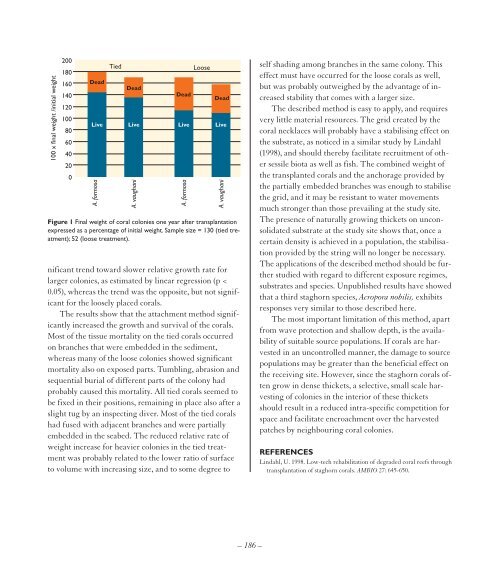Create successful ePaper yourself
Turn your PDF publications into a flip-book with our unique Google optimized e-Paper software.
100 x final weight /initial weight<br />
200<br />
180<br />
160<br />
140<br />
120<br />
100<br />
80<br />
60<br />
40<br />
20<br />
0<br />
Dead<br />
Dead<br />
Dead<br />
Dead<br />
Live Live Live Live<br />
A. formosa<br />
Tied<br />
A. vaughani<br />
Figure 1 Final weight of coral colonies one year after transplantation<br />
expressed as a percentage of initial weight. Sample size = 130 (tied treatment);<br />
52 (loose treatment).<br />
nificant trend toward slower relative growth rate for<br />
larger colonies, as estimated by linear regression (p <<br />
0.05), whereas the trend was the opposite, but not significant<br />
for the loosely placed corals.<br />
The results show that the attachment method significantly<br />
increased the growth and survival of the corals.<br />
Most of the tissue mortality on the tied corals occurred<br />
on branches that were embedded in the sediment,<br />
whereas many of the loose colonies showed significant<br />
mortality also on exposed parts. Tumbling, abrasion and<br />
sequential burial of different parts of the colony had<br />
probably caused this mortality. All tied corals seemed to<br />
be fixed in their positions, remaining in place also after a<br />
slight tug by an inspecting diver. Most of the tied corals<br />
had fused with adjacent branches and were partially<br />
embedded in the seabed. The reduced relative rate of<br />
weight increase for heavier colonies in the tied treatment<br />
was probably related to the lower ratio of surface<br />
to volume with increasing size, and to some degree to<br />
A. formosa<br />
Loose<br />
A. vaughani<br />
self shading among branches in the same colony. This<br />
effect must have occurred for the loose corals as well,<br />
but was probably outweighed by the advantage of increased<br />
stability that comes with a larger size.<br />
The described method is easy to apply, and requires<br />
very little material resources. The grid created by the<br />
coral necklaces will probably have a stabilising effect on<br />
the substrate, as noticed in a similar study by Lindahl<br />
(1998), and should thereby facilitate recruitment of other<br />
sessile biota as well as fish. The combined weight of<br />
the transplanted corals and the anchorage provided by<br />
the partially embedded branches was enough to stabilise<br />
the grid, and it may be resistant to water movements<br />
much stronger than those prevailing at the study site.<br />
The presence of naturally growing thickets on unconsolidated<br />
substrate at the study site shows that, once a<br />
certain density is achieved in a population, the stabilisation<br />
provided by the string will no longer be necessary.<br />
The applications of the described method should be further<br />
studied with regard to different exposure regimes,<br />
substrates and species. Unpublished results have showed<br />
that a third staghorn species, Acropora nobilis, exhibits<br />
responses very similar to those described here.<br />
The most important limitation of this method, apart<br />
from wave protection and shallow depth, is the availability<br />
of suitable source populations. If corals are harvested<br />
in an uncontrolled manner, the damage to source<br />
populations may be greater than the beneficial effect on<br />
the receiving site. However, since the staghorn corals often<br />
grow in dense thickets, a selective, small scale harvesting<br />
of colonies in the interior of these thickets<br />
should result in a reduced intra-specific competition for<br />
space and facilitate encroachment over the harvested<br />
patches by neighbouring coral colonies.<br />
REFERENCES<br />
Lindahl, U. 1998. Low-tech rehabilitation of degraded coral reefs through<br />
transplantation of staghorn corals. AMBIO 27: 645-650.<br />
– 186 –


















